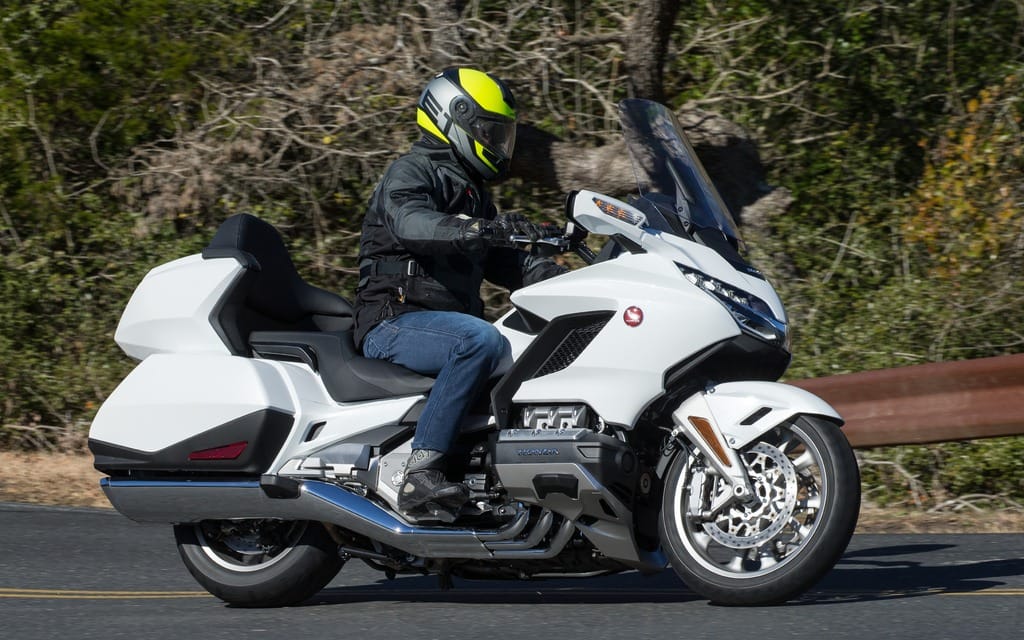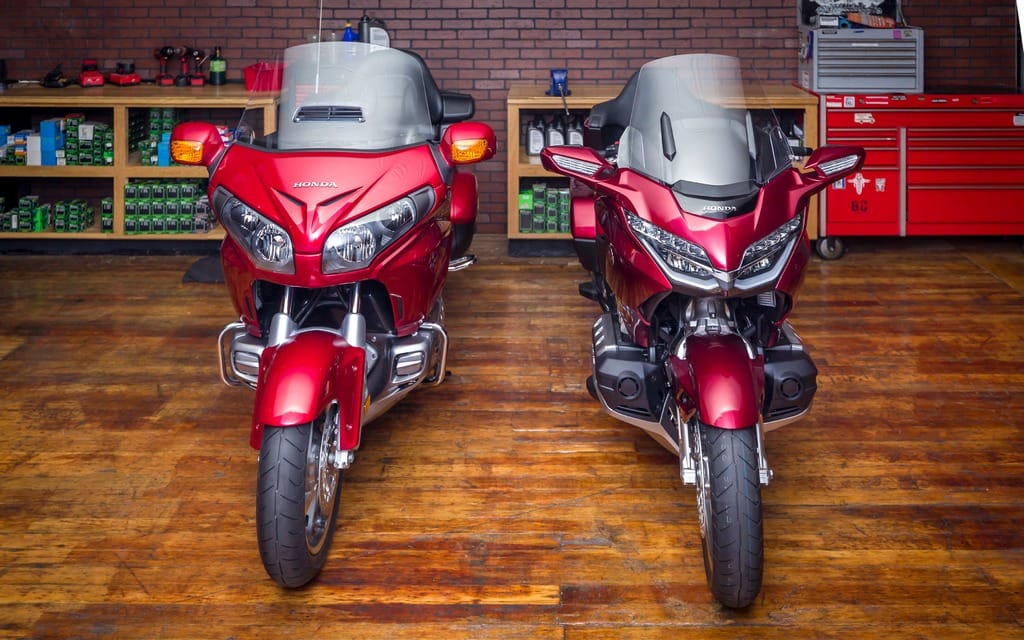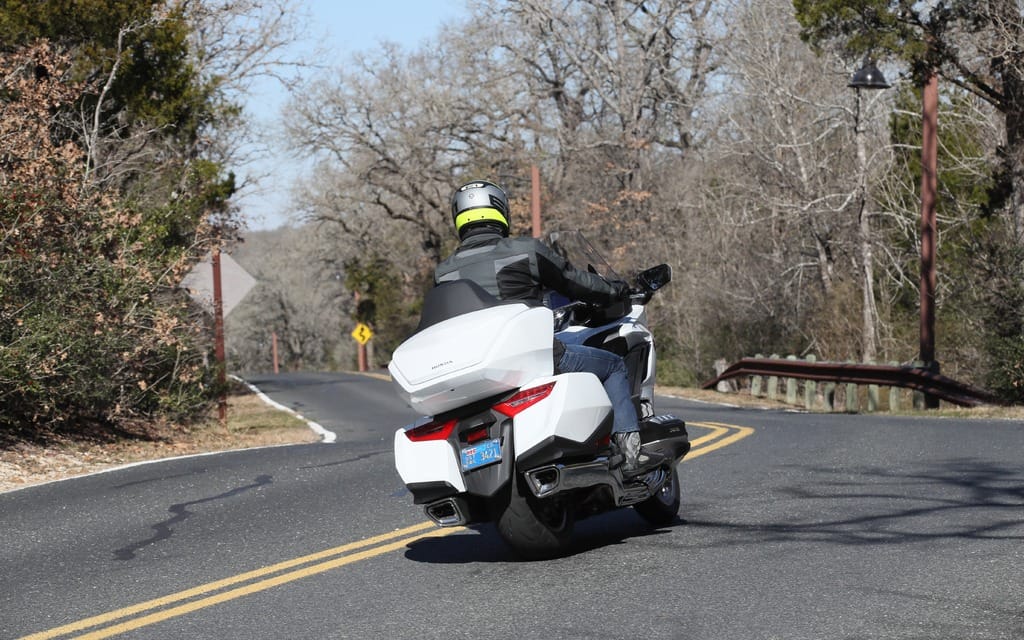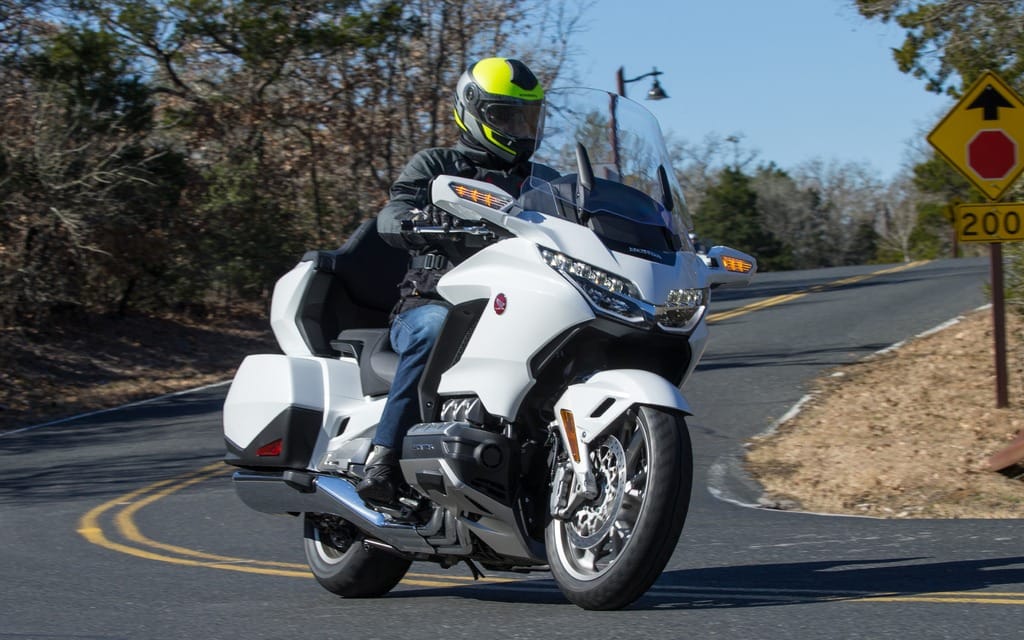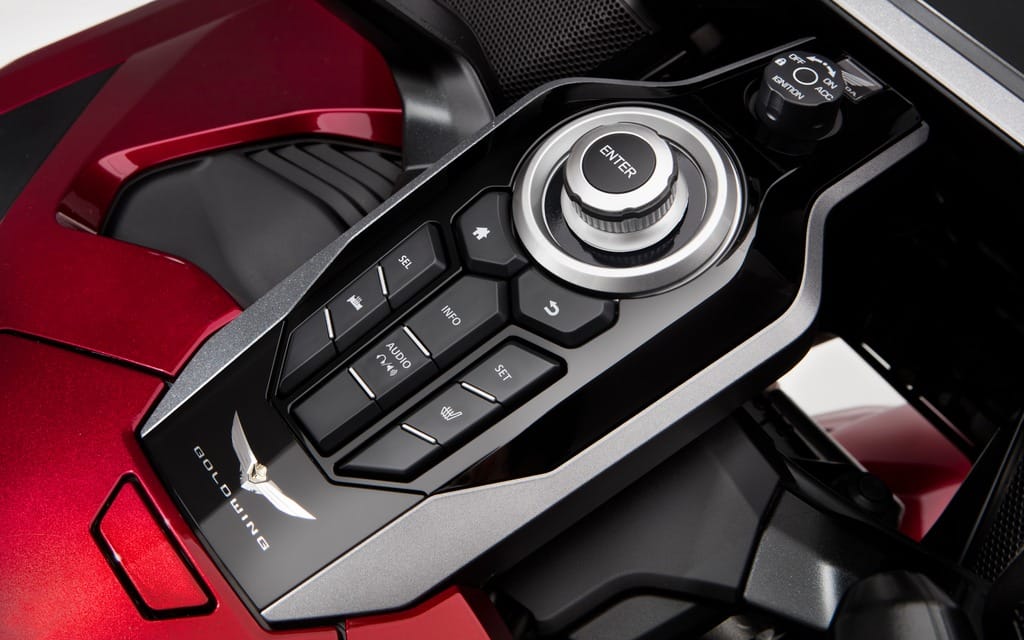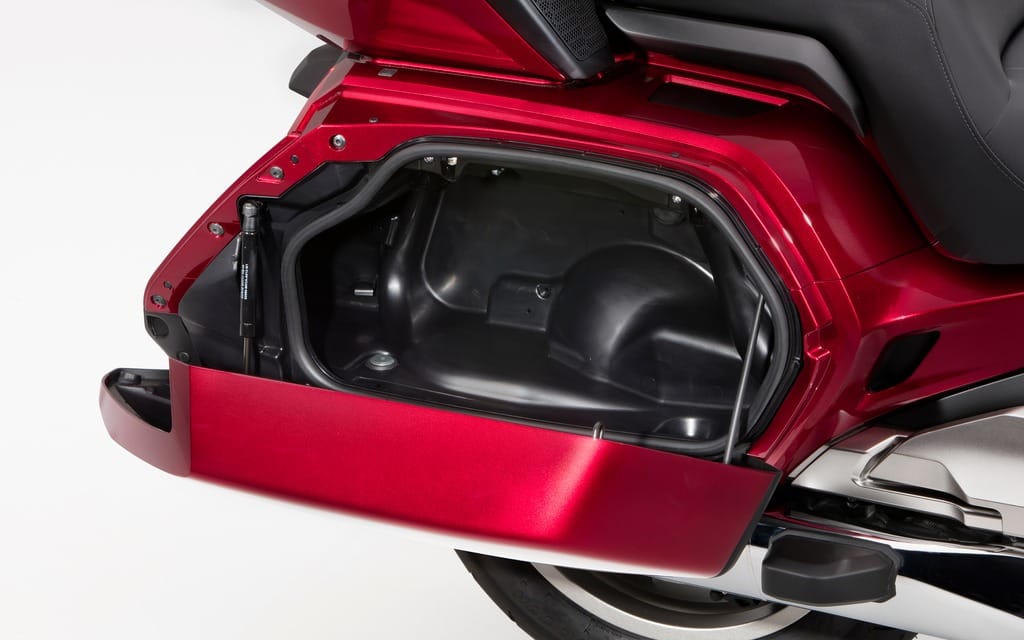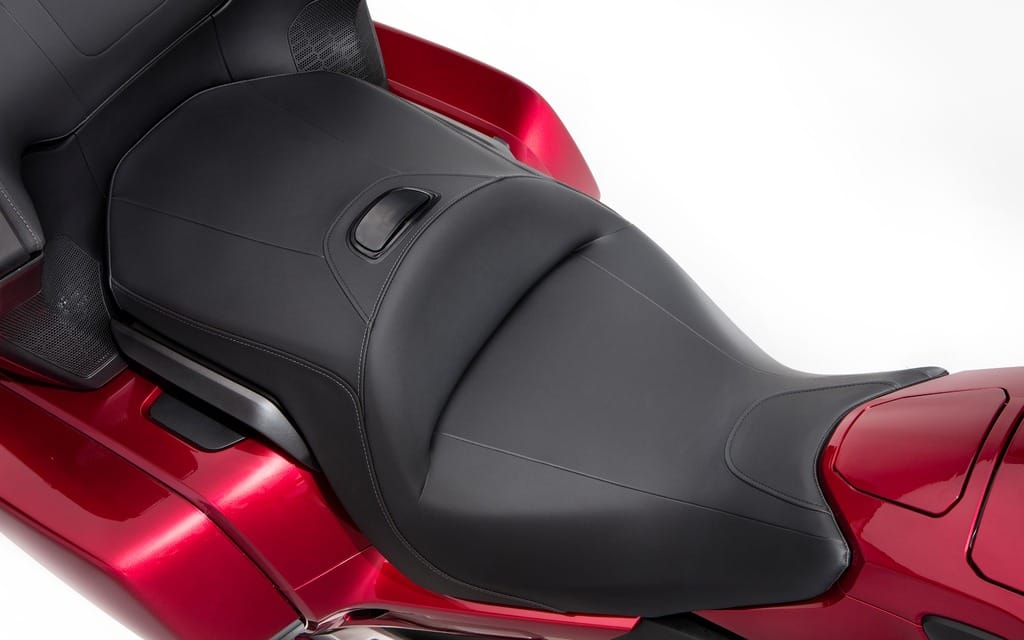Even a Texas freeze-up can’t stop Honda’s newest luxury bike
In Ice Cold Austin, Texas
You know the shit has really hit the fan when you’re warned to bring a heated vest to Texas. Call it climate change. Call it the dawn of the new Ice Age everyone’s talking about. Call it any damned thing you want. The one thing that is certain was that we all could have used a little pocket of global warming right around latitude 30.164974, longitude 97.447472 — that would be 24.2 miles east south east of Austin, by the way — where we were ostensibly supposed to test Honda’s latest Gold Wing.
Now, never mind the incongruity of freezing rain in Texas’s lower Hill country. Or that the TSA (that’s the American Transportation Safety Administration) didn’t bat an eyelash at my electric vest — for proper perspective here, picture Yours Truly passing through security wearing my bulky, fully-armoured Olympia Dakar jacket with an, uhm, electric cord dangling from its inner vest — in not just one but two preflight inspections. Thanks to weather that would comfort a polar bear, all the things that I had contemplated would be the focus of my preview of the first new Honda Gold Wing quickly became unimportant.
So while, at the sunnily tropic unveiling of the new Wing in tropical Santa Barbara, it was that funny, Hossack-style front suspension that captivated my interest, in frigid Austin, I was much more concerned that the much-heralded-but-largely-ignored-by-the-press super alternator — actually called an Integrated Starter Generator (ISG) —really did possess sufficient wattage for my Venture Heat vest. And while in sunny California I was in thrall of the newly torque-enhanced 1,833 cubic centimetre flat six engine, in a bitterly cold Texas, I was far more concerned about Honda’s claim that its smaller fairing was as protective as Honda’s wind tunnel suggested: As any two-wheeled road warrior will tell you, 100 kilometres of frigid wind is easily the equivalent of about 10+ amps — hence my concern about the alternator — of wind-chill. In other words, my priorities had changed, now probably more closely aligned with the pragmatics that concern everyday motorcyclists than typical go-faster motorcycle journalists.
So, for those thinking of ladling their ’18 Wing with accessories, I think it’s fair to say you’re not going to have a problem. Since said alternator — OK, starter generator — is robust enough to power one of those infernal Stop/Start systems (but only in Europe, thankfully) that plague automobiles, it makes almost certainly plenty enough amps to power electric vests (and gloves!) with enough wattage left over to power the Christmas tree lights some have come to ladling on their touring bikes and that would seem especially appropriate in this weather.
As for Honda’s contention that, despite its slimmed-down proportions, the 2018’s fairing offers as much wind protection as the previous barn door, that proves (largely) true. Despite being noticeably narrower — pictures don’t adequately capture the new Wing’s svelteness versus the old — protection from the elements was excellent. It’s really quite hard to fathom how the new Wing can redirect as much air as the old, since, in back-to-back rides, you’d swear the 2018’s svelte fairing/windscreen is barely 5/8ths the size of the 2017’s barn door. Nonetheless, it does provide wondrous protection, particularly considering its diminutive size. Perhaps all that gobbledy-gook that Honda tried to foist on us — see the Nov-Dec Cycle Canada for the explanation of how front suspension and a shortened engine allow the 2018’s superior aerodynamics — in its tech briefing in Santa Barbara actually has some merit.
The one exception to all this aerodynamic goodness is that the new — and, again, I must stress, narrower, since it really is incredible how much smaller the fairing/screen is — cockpit offers pitiful little coverage for the rider’s hands. While the previous barn-door — and, sorry for the repetition, but that really is the only metaphor apt for this comparison — offered protection from the elements for the rider’s mitts, the 2018 does not. In fact, sophisticated aerodynamics being more important than sheer girth in the’18, the mirror has a little bleed area between itself and the fairing to allow a little blast of turbulence-calming air past the outside of the screen. As I mentioned, it does that — there’s precious little buffeting to either jacket or helmet — but, in doing so, it does direct a mini jet blast of air right at the rider’s fingers. In normal circumstances, that would go completely unnoticed. With an equivalent wind chill of somewhere around -20C, however, my leather-covered digits didn’t stand a chance, no matter how many watts that new super alternator thingie was directing at the heated handgrips.
It’s all worth it though, because all that downsizing I’ve been prattling on about is just what the touring segment needs. Sat in the rider’s seat, the new Wing feels like a sport tourer compared with the tanker truck that the previous generation now seems. It’s lighter, a tad lower and oh so much less intimidating. Combine that with the thoroughly modern infotainment system and, where the 2018 Wing feels like the most modern of motorbikes, getting on the previous generation, even for a quick spin, feels like a traipse through yesteryear.
Indeed, although not usually the focus of a motorcycle road test, Honda’s new infotainment system is the bee’s knees. Perhaps, it’s because they’ve waited until all the other motorcycle manufacturers have made their mistakes. Maybe it’s because they not only kept it simple but emulated the best of automotive designs, but, whatever the case, the Wing’s new audio/entertainment system is simply the best in the motorcycle biz.
Basically what Honda has done is take BMW’s automotive iDrive system, cut out the myriad submenus and then logically organize the information according to a motorcyclist’s needs. Throw in redundant controls on the left handlebar to supplement the tank’s twiddly little mouse/trackpad and navigating through submenus for audio system, navigation and vehicle setting (which includes the traction control and preload settings for the Fancy Dan adjustable suspension on top-of-the-line models) has never been easier. Combined with, again, an automotive-like “home” and “back” buttons, it’s a doddle to operate. Well done, Honda, for finally getting motorcycle infotainment right.
As for those more fundamental issues — handling, performance, that funny front end — our abbreviated test drive (it was so cold, most of the roads were iced over) did generate some top-of-mind impressions. For one thing, the new Hossack-type front suspension is compliance personified. Where the previous damping rod front fork was harsh under compression and would judder on even mildly bumpy roads, the 2018’s front soaked up anything and everything a suddenly frozen Texas could throw at it. Add in a slightly revised Pro-Link single shock affair — complete with electronically controlled preload adjustment — and one has one of the smoothest rides in motorcycledom. Said smooth ride does not, however, compromise control. The front end may be plush but it is amazingly well damped — as opposed to mooshiness of the outgoing models — the aforementioned smooth ride the result of basic design rather than whimpy valving.
That said, the new Wing, despite being lighter — at 379 kilograms, the DCT-equipped Tour is some 36 kilos less than the 2017 Wing — steers a little heavier at low speed, seemingly a little reluctant to turn in and then, once leaned over a little truckish at returning to upright.
Some in the motorcycle press have been quick to point to the aforementioned Hossack suspensions’s multiple linkage and double A-arms as the culprit — the previous generation, despite its avoirdupois, is noticeably more nimble at low speeds. I suspect the real culprit lies not in the front, but in the rear, namely Honda’s decision to imbue the new Gold Wing with one of those fashionably huge 200/55-16 superbike-like rear tires.
I’m not quite sure why Honda decided to upgrade from the previous model’s 180/60-16. Despite the new Unicam valve-actuating mechanism and other tweaks, Honda’s big flat six is still not a speed demon and certainly doesn’t need more rubber on the road. I can only assume it’s a fashion thing. Unfortunately, I suspect it — and not the funny front end — is the reason for the heavier steering.
That said, high-speed stability is much improved. Turn in may be a little slower but the new Wing’s almost casual shirking of even gross imperfections in the roadway is exemplary. And since most Gold Wings spend more of their time prowling superhighways than strafing apexes, the tradeoff is not unwelcome.
Honda, if you’ve been listening to their marketing efforts at all, has been downplaying the benefits of the new flat six engine other than its being noticeably shorter — again see Nov-Dec Cycle Canada for the logic behind the new Wing’s smaller engine that helps its aerodynamics — and treats any power increase as almost incidental. And, in fact, the 2018 feels only marginally more responsive than the ’17 and most of that is probably the result of weight loss. But — and this is a surprise since I never thought of the previous Wing’s engine as coarse — the engine is noticeably smoother, especially on overrun and when being lugged low in a taller gear. There’s also noticeably less gear noise. Considering that the existing flat six was considered a paragon of sophistication, that’s saying something.
Other details impress. Although the seat is still two-tiered, it is not the “King and Queen” perch of Wings recently passed. That means it offers more room for movement and is less inhibiting when you’re putting your feet down at a stop sign. Broad and flat, it’s also very supportive despite its firmish, BMW-like padding.
More questionable is the reduced luggage capacity. Both saddlebags and topcase are smaller than the pervious model’s — 30 litres for each of the side bags and 50 for the rear topcase — the reduction easily noticeable since the saddlebags look more apropos for a bagger than a full-boat tourer. That said, Honda says that fewer Wings are being used for cross-country tours, more important now, it seems, the long weekend getaway. This is a demographic rather than a performance criterion and the wisdom of Honda’s decision will only be rendered once the year-end sales figures come out.
I suspect, however, that said marketplace is going to react quite positively to Honda’s first new Gold Wing in 16 years. Virtually all high-tech additions — from digital to hydraulic — are massive improvements over the old. The 2018 Gold Wing Tour is, as I said in the beginning of this treatise, the very definition of a very modern motorcycle.
The 2018 Gold Wing Tour retails, in its base guise, for $30,799, costs $31,999 when you throw in the dual-clutch transmission and touches $34,599 for the all-singing all-dancing version with DCT and air bag. The basic Gold Wing — what we know as the F6B, but which I got little opportunity to ride in Texas — starts at $26,999.
